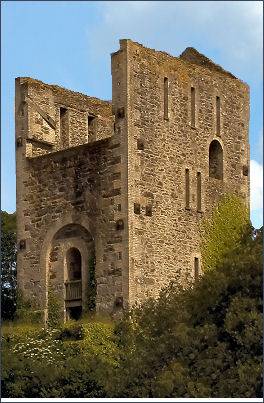St. Newlyn East
OS Grid ref:- SW8256
 St. Newlyn East, known in Cornish as Eglosniwlin, is situated around seven miles south of the popular coastal resort of Newquay and is an ancient village.
St. Newlyn East, known in Cornish as Eglosniwlin, is situated around seven miles south of the popular coastal resort of Newquay and is an ancient village.
It was not referred to as Newlyn East until the village of Newlyn was developed on the western edge of Penzance.
 The village church was dedicated to St. Newlina the Virgin ( St Newelina) on "the Friday after St. Matthew" in September 1259, St. Newlina was of Welsh extraction and was believed to have been martyred by her father. The building is part Norman. Much of the present building is of fourteenth and fifteenth century dates, it was restored in the late nineteenth century. The font dates from the Norman era. The church contains the family vault of the Arundells of Trerice.
The village church was dedicated to St. Newlina the Virgin ( St Newelina) on "the Friday after St. Matthew" in September 1259, St. Newlina was of Welsh extraction and was believed to have been martyred by her father. The building is part Norman. Much of the present building is of fourteenth and fifteenth century dates, it was restored in the late nineteenth century. The font dates from the Norman era. The church contains the family vault of the Arundells of Trerice.
In the nineteenth century St. Newlyn East was a thriving mining community. The East Wheal Rose Mine (pictured right) was sited in the valley of a small stream at the point where it opens out into a natural bowl and is virtually surrounded by hills. The village was the site of one of Cornwall's worst mining disasters on 9th July, 1846, when unusually heavy rain during a violent thunderstorm which lasted an hour and a quarter flooded the East Wheal Rose Mine. Despite efforts by the men on the surface to dam or divert the water from the shafts the mine was rapidly flooded up to the 50 fathom (300 feet) level, and of the estimated 200 miners who were underground at the time, 39 local men and boys were drowned.
The miners dug a 'Pit' in the village as a memorial and as a gesture of remembrance, which has ecently re-dug and made more usable with funding from the National Lottery Fund. The mine was eventually closed in 1881. Today, apart from the preserved engine house and chimney stack, there are few remains of the mine visible and the site is a tourist attraction with a boating lake and crazy golf.
There is an imposing manor house at Trerice, supposed to have been built in 1570. It is a small Elizabethan manor house, about 4 miles south of Newquay, which was once the home of a younger branch of the Arundells. The house boasts a collection of high quality English furniture, clocks, needlework and Stuart portraits. The Great Hall boasts an elaborate plaster ceiling and a minstrel's gallery. The drawing room on the first floor has an elaborate overmantel. The hay loft in the Great Barn sets out in intriguing detail the part played by its owners in the time of King Henry VIII and in the English Civil War.
Trerice is now owned by the National Trust and is open to the public.